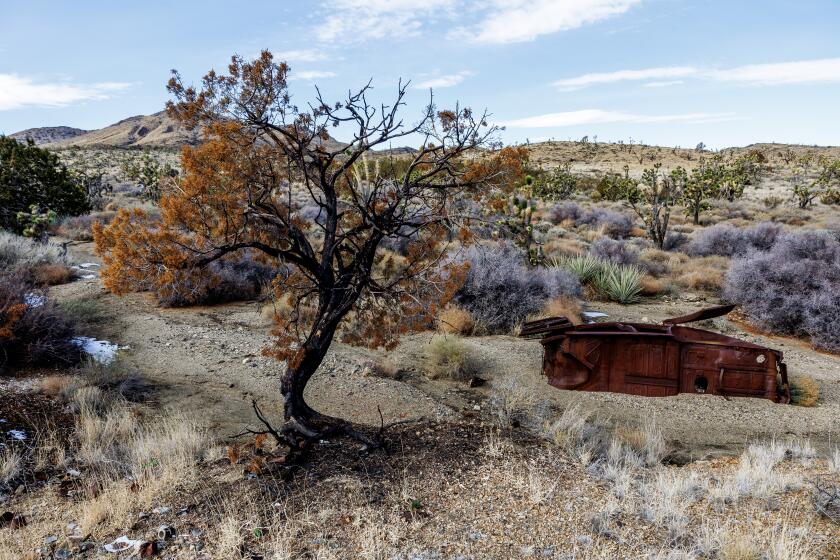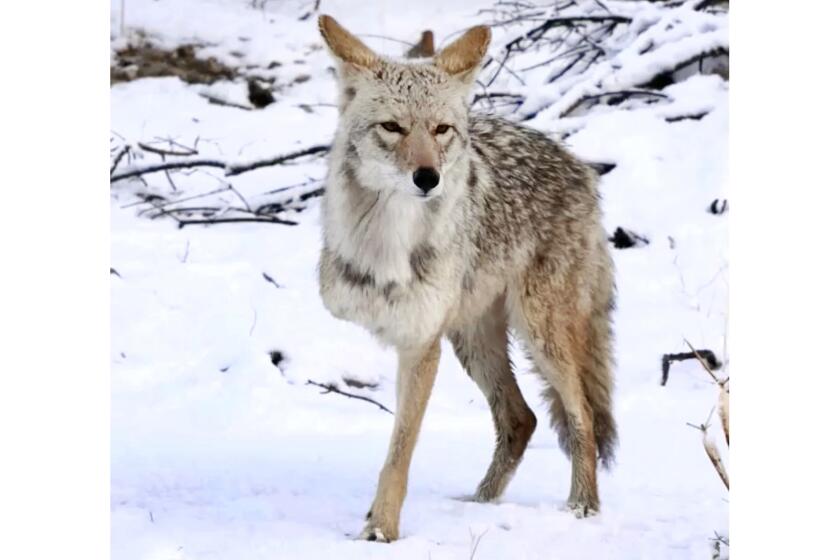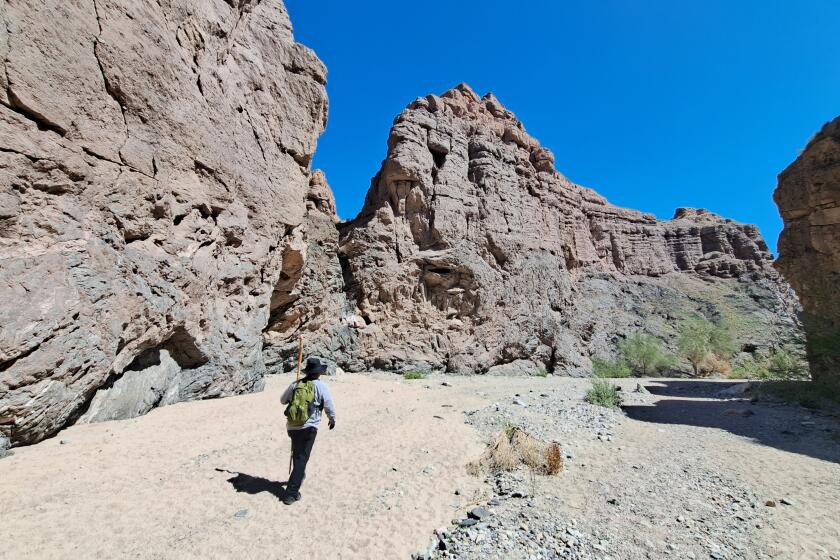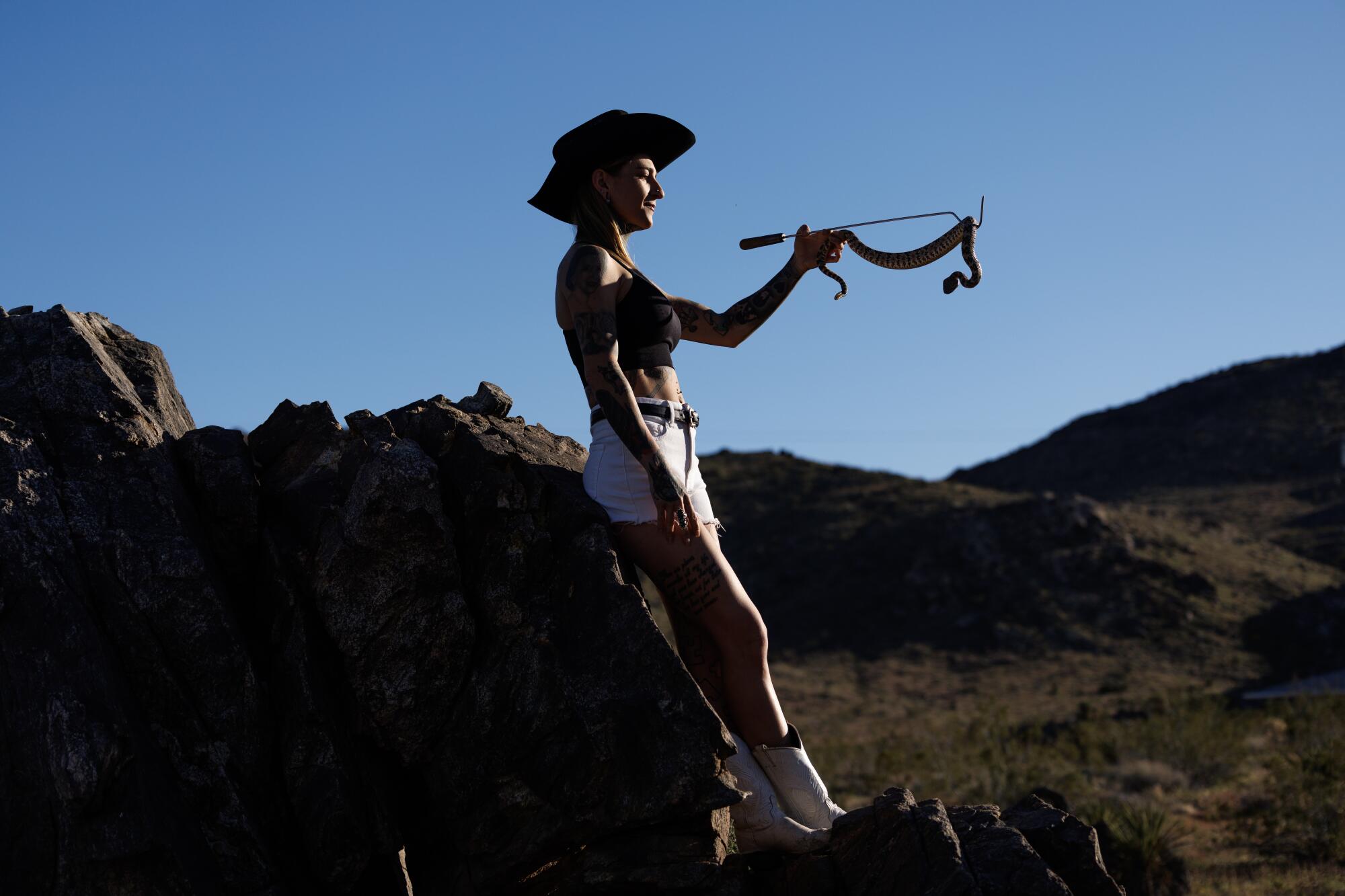
- Share via
LANDERS, Calif. — Spring marks the start of the high desert’s slow season. Beneath a blanket of scorching heat, tourism drops. Restaurants and stores shorten their hours.
But for Danielle Wall, business begins to pick up.
The tattooed, cutoff-clad 29-year-old has become the Joshua Tree area’s premier rattlesnake wrangler. From April through October, she fields phone calls, texts and social media messages from people who want her to remove venomous visitors from their properties.
Aggressive and impactful reporting on climate change, the environment, health and science.
Her work has earned her a front-row seat to the profound changes that have reshaped this slice of the Mojave Desert over the past few years, as pandemic-era policies attracted hordes of investors and new residents. In the process, Wall has also transformed how locals interact with the much-maligned — unfairly, she’s quick to point out — reptiles.
“I always tell people I’m afraid of two things: men and distracted drivers, and that’s it,” Wall said.

It’s 12:45 p.m. in mid-April, a Tuesday. Wall is on her way to her eighth snake call of the day.
Four resulted in successful removals. Two ended up being for nonvenomous snakes, which she typically does not relocate. And one rattlesnake beat her, “fair and square.”
“That thing — it outsmarted me. It did, man,” she says, recalling how the snake dove down a pack rat nest as she tried to get her tongs around it. “It hasn’t happened in like three years.”
Wall drives up a sandy road lined with Joshua trees and dotted with sprawling ranches. She pulls through a metal gate and into the driveway of a home that’s being renovated. A crew of workers is waiting for her. They seem eager to catch a glimpse.
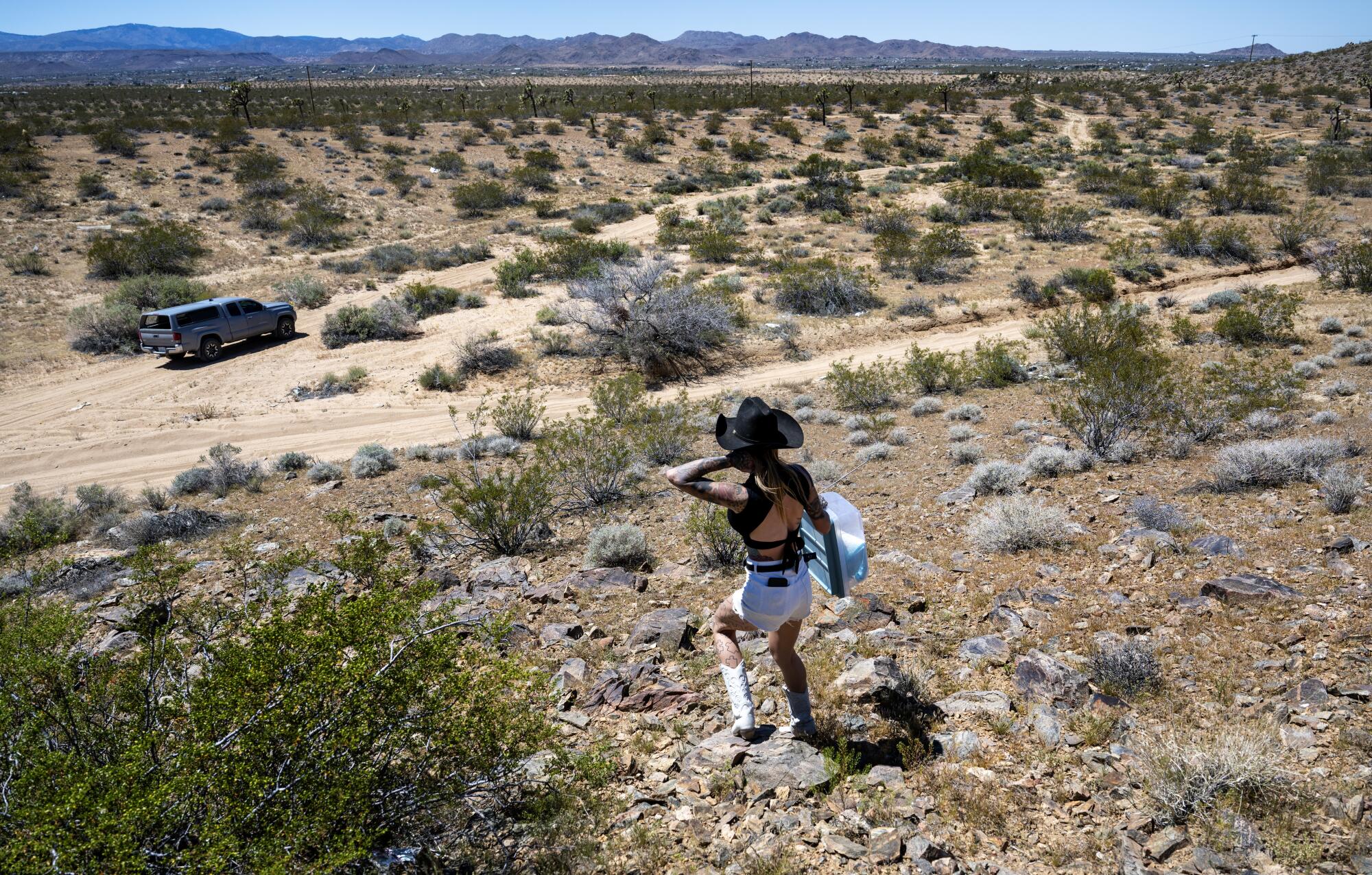
“She’s a celebrity,” said Mason Palanuik, 20. “Everyone knows her — or knows of her.”
After checking the perimeter, Wall learns it’s been over an hour since the men spotted the snake — a fact that had not been made clear in the initial call, she says. She decides to cut her losses. After giving the crew a bit of a hard time — and telling them to watch out the next time they pick up a box or a piece of plywood — she climbs back in her Tacoma and drives off.

Wall likes to say the rattlesnakes found her. Roughly six years ago — about two years after she moved to the desert from Santa Rosa — she was driving home from her job at a wedding venue when she nearly ran one over. She got out of her car and poked it with a stick. It took off.
“I was like, ‘Well, that wasn’t that scary,’” she said.
At the time, she was in her final semester of college, studying forensic entomology. She had always been into nature, specifically bugs. Insects were a way of escaping a childhood that felt lonely.
But after that snake encounter on the road, Wall did some research. She learned there was no local 24/7 service to humanely relocate rattlesnakes. Animal control, for the most part, would kill them on-site, she said.
1
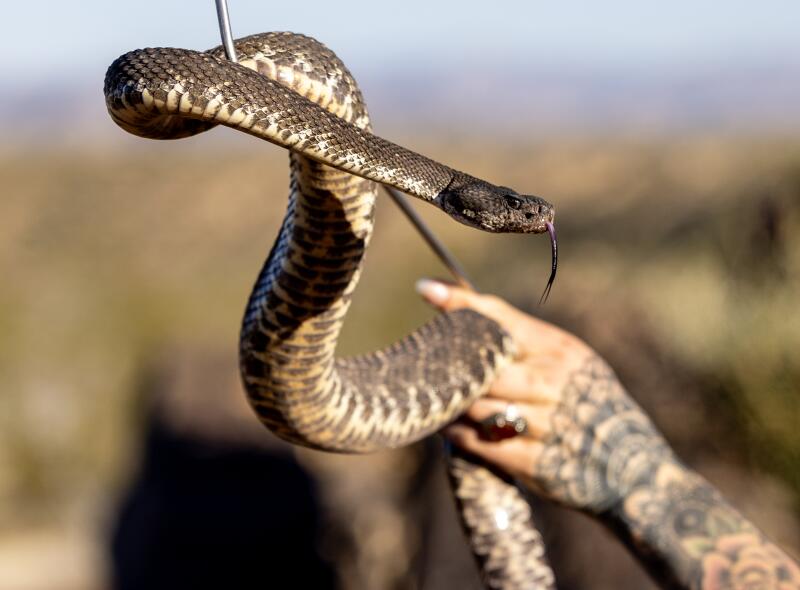
2

3

1. Wall holds a Southern Pacific rattlesnake. 2. With a tattoo of her grandmother, Vida Piantanida, visible on her right arm, Wall checks GPS coordinates for where she can release snakes. 3. Yes, Wall keeps rattlesnakes at home. She also has dogs and cats, tortoises and a 5-foot green iguana named Picasso.
She also learned that rattlesnakes have unique personalities, “really cool” family structures and even the capacity to comfort one another.
“They’re so much kinder than people give them credit for,” she said.
And yet, misunderstood: “They have similar behavior to a scared kitten, where that kitten is not going to jump at your face, but if you corner it, it will scratch to get away.”
Last year’s York fire has sparked discussion about how to deal with conflagrations in the Mojave National Preserve.
Four days later, Wall saw a Facebook post by a woman who wanted a rattlesnake off her property. Most people who responded advised her to kill it. “So I commented, ‘I got a stick and a bucket, can I try?’” Wall said.
To her surprise, the woman agreed. Perhaps even more surprisingly, the relocation was successful. And Wall was hooked. She dropped out of school.

Subscribers get exclusive access to this story
We’re offering L.A. Times subscribers special access to our best journalism. Thank you for your support.
Explore more Subscriber Exclusive content.
“She changed my life on that one call,” she said. “It was so exhilarating, to save something that people hate, fear.”
That season, Wall did about 50 calls. The next — which she describes as when she started getting good — she did about 150. After the third season, Wall went all in, quitting her day job to make more time for snakes.
Her social life took a hit. She left her own birthday party five years in a row to go on snake calls.
“I lost a lot of friends and just connections because I turned into this weirdo that only wanted to spend time at home or saving snakes,” she said. “And I’m OK with it. I don’t care. But that’s who I turned into. These snakes turned me into a little bit of a wildlife recluse because they kind of showed me that’s a nice way to live.”

Wall’s business is a barometer of a changing desert.
A boom in new home construction or major renovations? More snake calls. Heavy machinery dismantles their hideouts and drives them from their burrows with intense vibrations.
Periods of drought? More snake calls. Thirsty reptiles slither into people’s yards seeking a drink.
Sign up for This Evening's Big Stories
Catch up on the day with the 7 biggest L.A. Times stories in your inbox every weekday evening.
You may occasionally receive promotional content from the Los Angeles Times.
The COVID-19 pandemic was a perfect storm. Low interest rates, work-from-home policies and a newfound need for social isolation lured scores of new residents to the desert, where they embarked on ground-shaking home building or improvement projects. Investors flipped yet more properties to short-term rentals. The entire area seemed to be under construction.
City slickers at home all day, bored and lonely in an unfamiliar landscape while bulldozers rearrange the desert floor and severe drought parches the local wildlife? Way more snake calls.
In fact, that was Wall’s busiest season to date, with more than 400 removal requests.
“People were inviting me into their homes. They were talking about their traumas,” she said. “I almost lost it that year.”
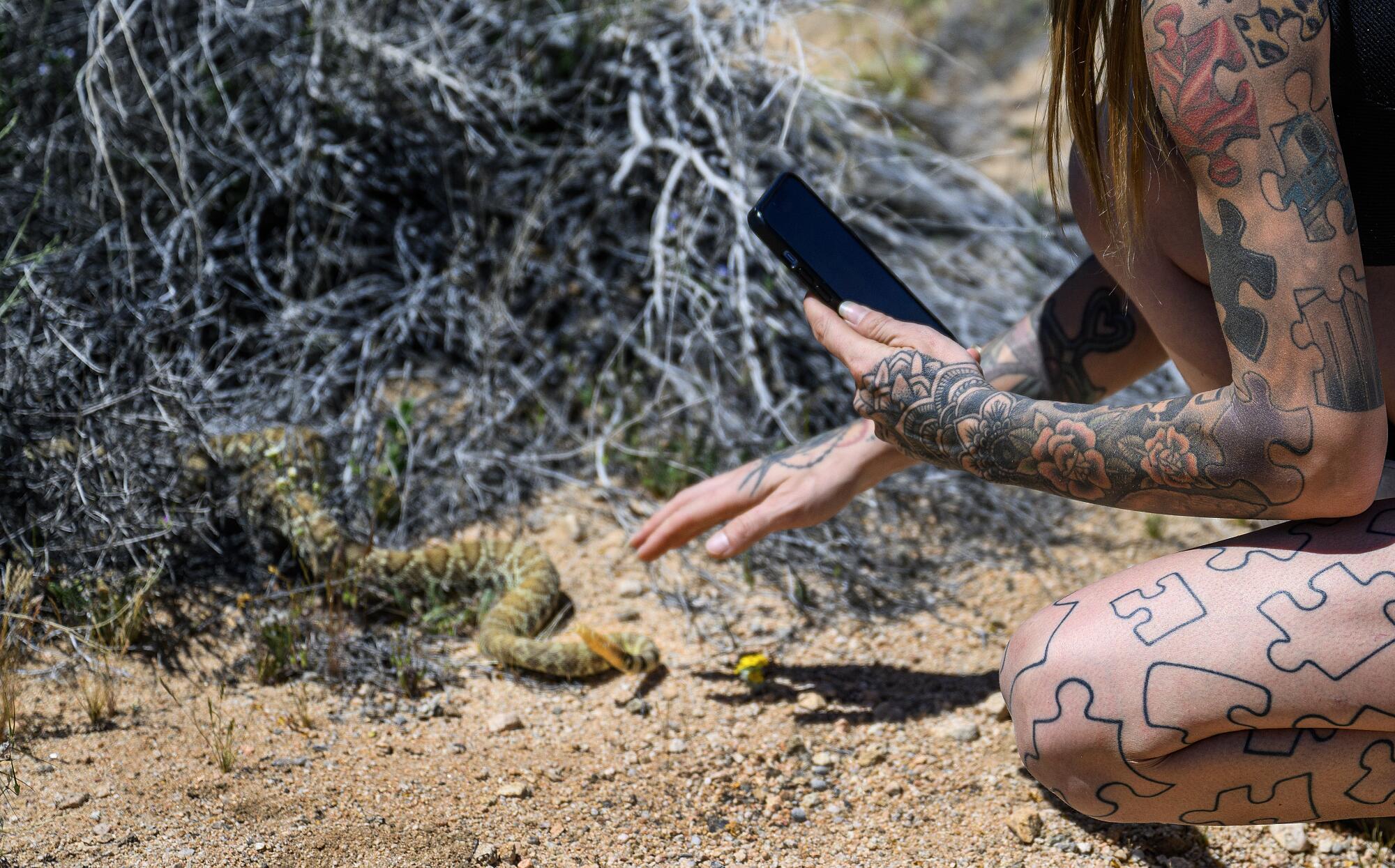
As skyrocketing home prices pushed out locals, Wall watched as those same changes also took a toll on the delicate ecosystem. An increase in trash attracted more ground squirrels and ravens, the latter of which feed on the young of endangered desert tortoises. The prodigious use of rat poison decimated the population of birds of prey that eat rodents, which has resulted in the local rodent population growing. Ornamental plantings crowded out native species.
“The balance is being really messed up,” she said.
“In my opinion, it’s all a losing battle because people will never stop being so selfish,” she added. “But I’m gonna spend my little time, my chunk of life here, just helping people, helping the snakes.”

Later that afternoon, after she ribbed the construction crew, Wall drives into the backcountry of Landers with three Tupperware-like containers in the backseat of her truck. Inside each, a rescue. When the ride gets bumpy, they rattle and hiss.
She pulls up a map on her phone. Rattlesnakes have to be relocated at least a half-mile from any occupied property, but ideally no more than a mile or two from where they were found. They rarely travel outside of a one-mile radius over the course of their lives.
“If you really drastically move them, it’s like moving us across the state and saying, ‘Good luck,’” she said.
Later in the season, when it gets hotter, Wall will slip ice packs into the snakes’ boxes, but today it’s a temperate 80 degrees.
Everybody loves Tripod the three-legged coyote, but High Desert locals say that visitors are spoiling the beast with handouts and causing a dangerous situation.
The first snake to be released is a Mojave green. After a brief hike through some scrub, Wall finds a creosote bush studded with holes at the roots — evidence of pack rats that will provide the snake with sustenance. She uses a 2-foot hook to neatly scoop the rattler out of the box and gently coaxes it into the brush with some words of encouragement.
The next two rescues are speckled rattlesnakes, which thrive in rocky environments. Wall scales a jagged boulder pile and releases the first: a baby — “squiggly nugget,” in her parlance.
The word choice — and even the short-shorts and crop tops Wall wears — is intentional. Her mission is to subvert the stereotype, common in popular culture and advanced by some testosterone-fueled fellow reptile handlers, of rattlesnakes as vicious predators.
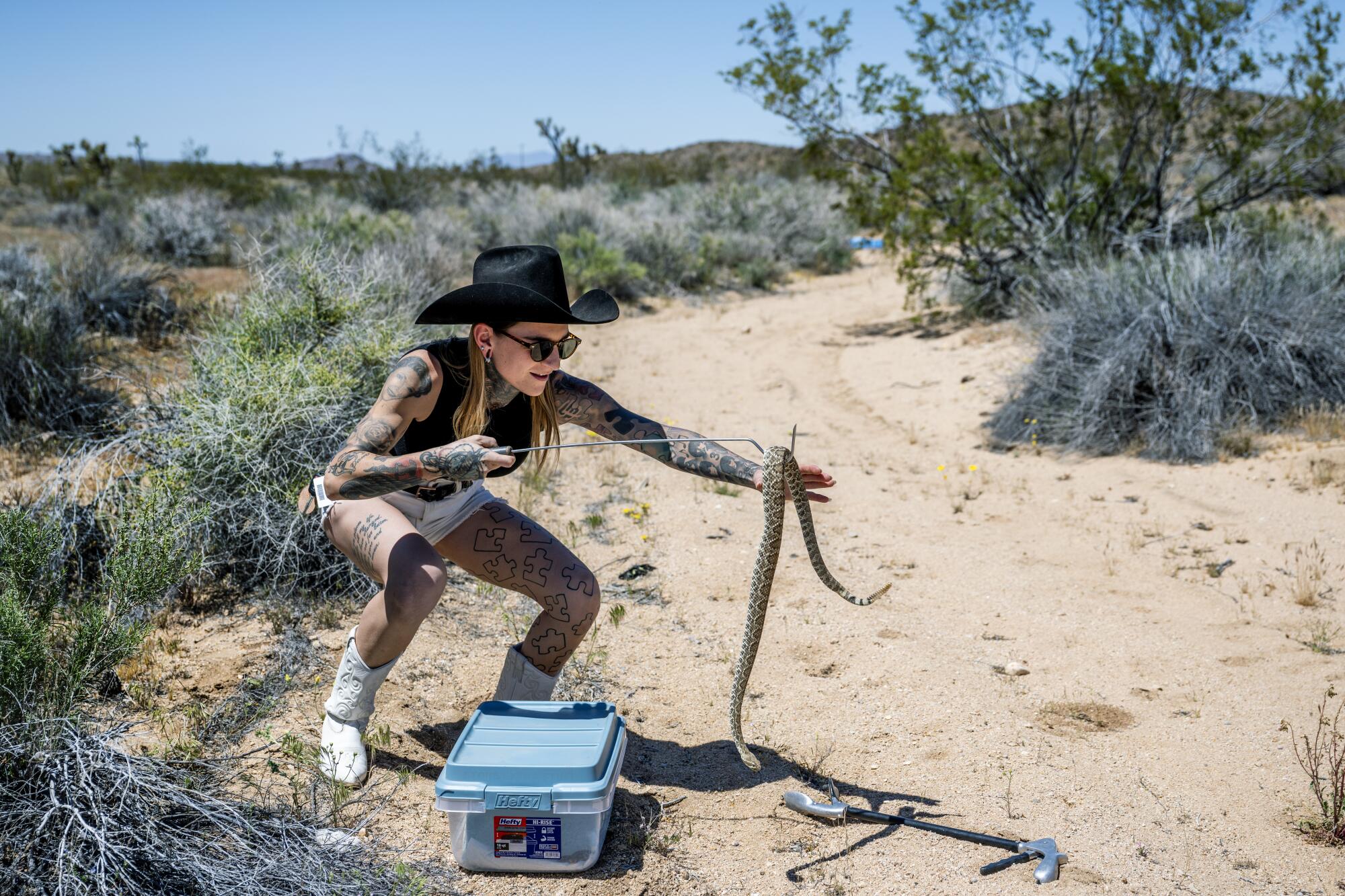
“I am a 100-pound, 5-foot-2 female in booty shorts and a tank top calling this snake cute, and meanwhile you got some macho dude telling everyone how dangerous and aggressive it is,” she said. “I want to show people that everything they ever heard about snakes is bull—.”
Wall has received quite an education in her time as a snake wrangler. She’s learned to navigate a maze of laws and regulations that require her to relocate rattlesnakes within 72 hours, to refrain from handling certain species and to never profit from her work. She’s learned to wear 10-inch or taller boots to avoid ankle bites (while she’s never been bitten, a hidden snake once struck at her boot in self-defense “when I damn near stepped right on him”). She can gauge a rattlesnake’s strike range from looking at its size and position.
On top of all that, she’s also had to learn how to move through this world as a woman — one who has garnered a good deal of attention despite not being entirely comfortable with it. Some of her detractors have leveled death threats and personal attacks that have veered into stalking. It’s not uncommon for random men to proposition her online and then lash out when she rejects them.
Before leaving for a call, Wall shares her location with trusted family members or friends, fearing someone could lure her to an isolated spot under false pretenses. The Mojave desert is full of desolate back roads carved into giant parcels of raw land, long-forgotten homesteads, abandoned mines.
“As a tiny woman who is known for her, I guess, sex appeal — coming from me as a band nerd, I still don’t understand it; it’s not in my brain that I’m attractive — but yeah,” she said. “That is a genuine fear of mine.”

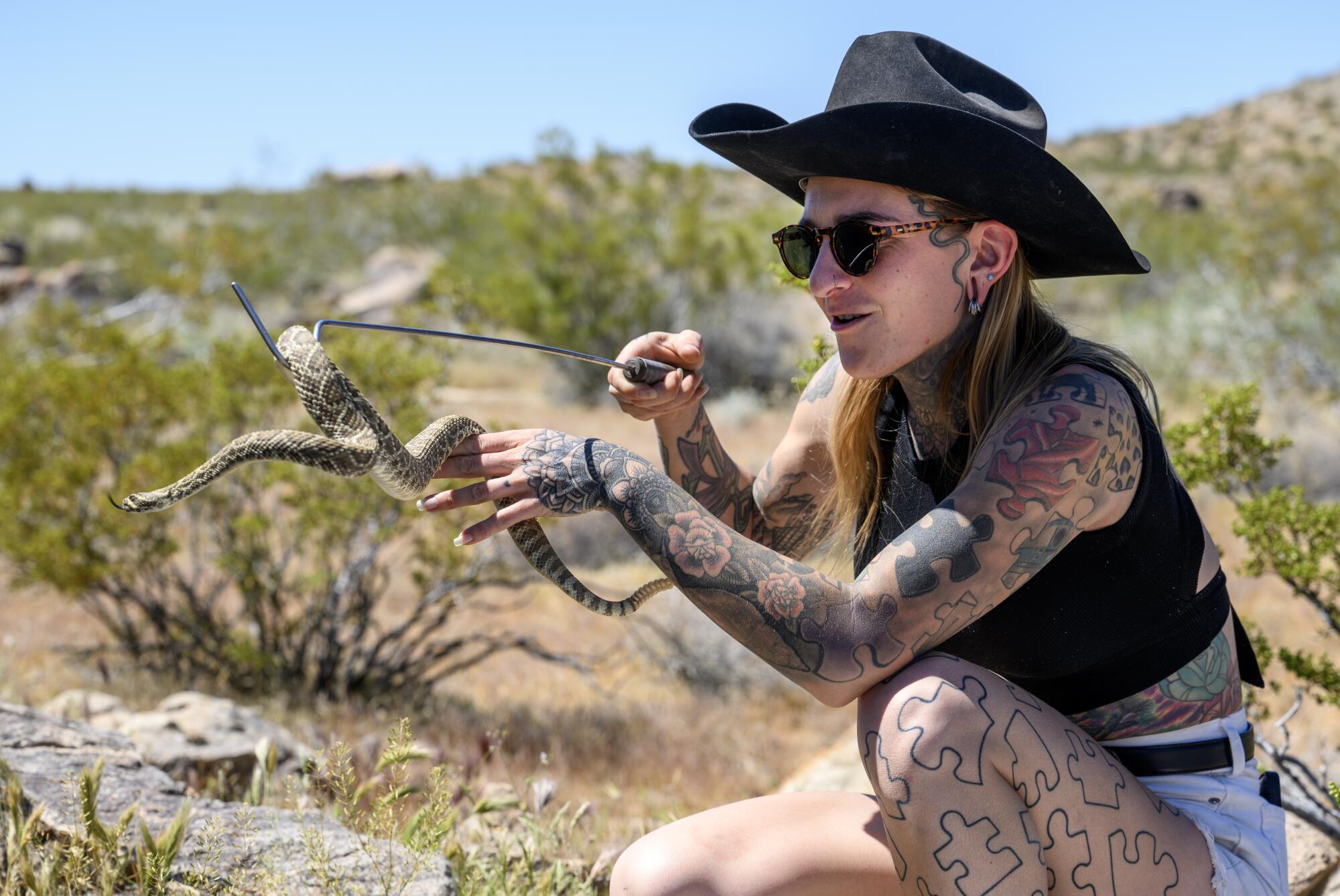
Back at home, Wall curls her shoulders in exhaustion.
The self-described hermit lives on a generous spread, which she purchased from her great-grandparents and is slowly rehabbing. A workshop is dedicated to custom-built enclosures for her snakes (she owns pretty much every species of California rattlesnake except the federally-protected red diamond); three tortoises and a 5-foot green iguana named Picasso. A bedroom is occupied solely by her four cats.
“You in the ken? You in the ken ken?” Wall coos to one of her two dogs, which is whining from inside a kennel in the living room. “She’s a trained guard dog. She’ll go for the ... thigh.”
Indigenous Californians want President Biden to establish a national monument in a stretch of desert that is both an ecological wonder and a window into their cultures.
It’s now nearly 2 p.m., and Wall has had neither coffee nor a shower. She’s worked the equivalent of a full day and brought in just $120 in donations, which will cover the gas she burned crisscrossing the high desert but little else. Over a season, she’ll typically dip into her own pockets to cover expenses, to the tune of $1,000 to $3,000.
“I have always been in the red, every month. Every time,” she said. “And that’s fine, I volunteer to do this. And legally in California, I can’t become a nonprofit snake wrangler, or the laws are very difficult for me to work around.”
California law prohibits Wall from operating as a business, and certification as a nonprofit wildlife rescue would require navigating a complex system of permitting and government approvals. Wall describes a frosty relationship with most animal control authorities, although she says the local sheriff’s and fire departments, which tend to field the emergency calls, are supportive.
Because she lacks nonprofit status, donations aren’t tax deductible, which hampers her from pursuing sponsors. She’s looking into whether she can become a nonprofit educator instead, as her services typically involve a brief lesson. She also appears at local elementary schools, youth clubs, “whoever wants to hire me and learn about snakes.”
But Wall’s interest in garnering attention begins and ends with the reptiles. She’ll accept publicity spots if she feels it’s in their best interest, but she’s adamant she won’t be “paraded around” simply to raise her own profile. She has turned down a television show pilot and documentary, along with offers to monetize her social media presence. She supports herself by renting out a small house on her property and taking the odd professional cleaning job.
Still, she’s seen her work pay off in less tangible ways. She’s trained two assistants. And the hundreds of people she’s counseled during snake removals or educational appearances have passed those lessons on to neighbors, friends and parents.
Now, when someone posts on Facebook that they’ve found a rattlesnake on their property, “you see me tagged 100 times and maybe one person saying, ‘just kill it,’” Wall said.
“And everyone else on that thread is reaming out that one person for saying ‘kill it.’ Because now we know a little bit better. We have options.”
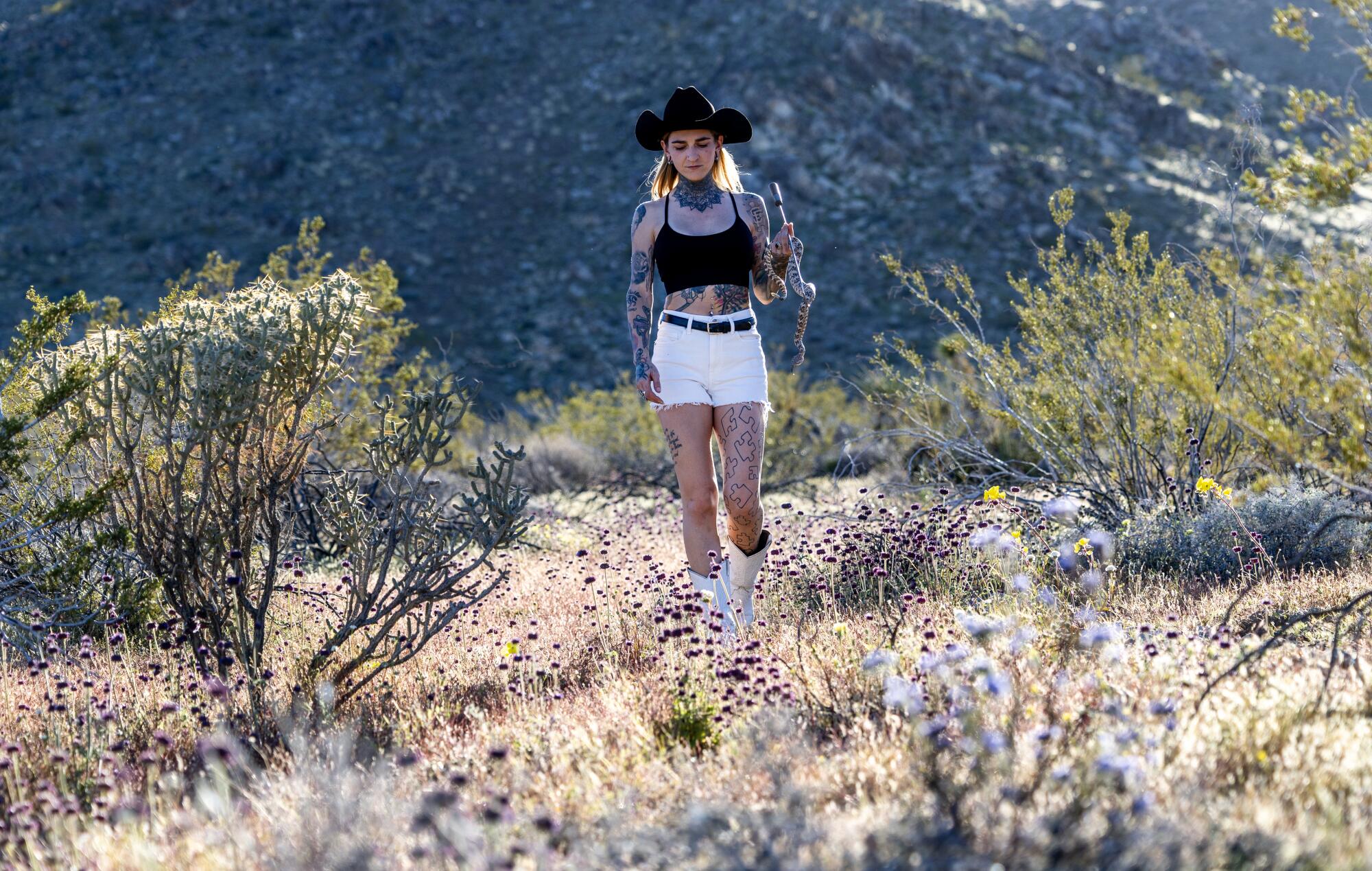
More to Read
Our oceans. Our public lands. Our future.
Get Boiling Point, our new newsletter exploring climate change and the environment, and become part of the conversation — and the solution.
You may occasionally receive promotional content from the Los Angeles Times.

